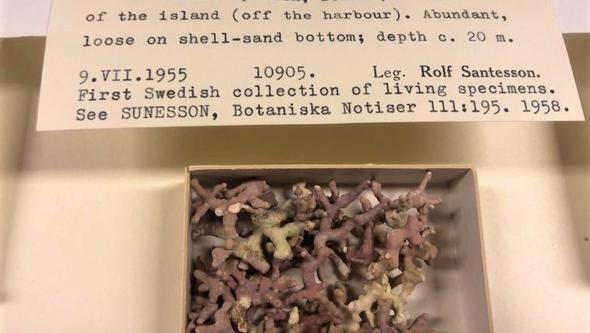Fantastic maerl
Short description
The occurrence and importance of maerl beds, benthic marine habitats consisting of calcareous red algae, is a major knowledge gap in Swedish waters. In other parts of the world it is known that these beds support high biodiversity and provide climate regulation, hence offering several ecosystem services. However, due to their susceptibility to anthropogenic stress and slow growth rates, they are under threat and in rapid decline. This project aims to establish the distribution, importance and vulnerability of these biogenic reefs in Swedish waters, vital information for the understanding of this marine habitat and its role in the economics and ecology of Swedish coasts. Our results will provide the essential baseline knowledge of maerl needed for national and international management plans.
A comprehensive assessment of the occurrence and importance of Sweden's hidden marine biogenic reefs
Maerl are free-living, often branched, red calcareous algae that build up reef-like ecosystems called maerl beds. The structure of these beds offers suitable habitats for myriads of marine organisms. They can, for example, be used as nursery grounds as there are plenty of opportunities for protection, also used by adult organisms to avoid predation. Many animals find food in these areas, both carnivores but also herbivorous animals as there are plenty of macroalgae attached to the maerl. Commercially important fish and shellfish, such as cod and scallops, spend parts- or their whole life cycle in maerl, hence, making these habitats important for the fishing industry. They are also efficient calcium carbonate factories, important for maintaining the ocean's buffering capacity and balance. However, maerl are sensitive to anthropogenic stressors such as ocean acidification, dredging, thrawling, and increased temperature. This, combined with their difficulty to recover due to slow growth rates, has resulted in a drastic reduction of these ecosystems worldwide. All these fantastic ecosystem services are then at risk of being lost. The current maerl knowledge come from various places on the planet, but the distribution and function of maerl beds in Swedish waters is still unclear. Occurrence of Swedish maerl has mainly been reported in the Kattegat, on the off shore banks of Fladen and Lilla Middelgrund, but also in the Skagerrak in various parts of Kosterfjorden. No direct inventories specifically focusing on maerl seem to have occurred in Sweden, perhaps because it is such an unknown habitat type.
Within this project, we intend to put maerl on the map, literally. We will use historical reportings, GIS modeling, field surveys and citizen science engagement to map the presence of this nature type. To gain an understanding of how important maerl is for marine ecosystem services, evaluations of this, with a focus on biodiversity and climate regulation, will take place. The role of biodiversity will be investigated through an inventory of flora and fauna. Here, underwater video and grab samples will form the basis for determining which invertebrates and macroalgae are found among the maerl. This will be compared to a habitat type with similar character but without maerl, to determine whether the calcareous algae offer a preferred habitat. Fish species connected to maerl, as well as connectivity between maerl and surrounding ecosystems, will be investigated through eDNA. This to assess whether maerl is an important habitat for the Swedish fishing industry. Laboratory experiments will establish the algae's capacity for carbon storage and calcium carbonate production, in a current but also future perspective. Several Swedish, but also international reports, have highlighted maerl as an important habitat with high natural values, however, all of these have pointed out the prevailing lack of knowledge regarding occurrence and function. The aim of this project is thus to collect, evaluate and deliver timely information to increase the understanding of this unique marine habitat. As this is currently lacking, this is highly important and urgent to establish national management plans to protect these marine ecosystems before it is too late.

Deltagare:
Lina Rasmusson (University of Gothenburg)
Tom Staveley (SLU Aqua Drottningholm)
Jason Hall-Spencer (University of Plymouth / University of Tsukuba)
Sam Dupont (University of Gothenburg)
Mathieu Helias (Université de Caen Normandie)
Emily Stragapede (masterarbete – Göteborgs universitet)
Mckenzi Doulthon (masterarbete – Göteborgs universitet)
